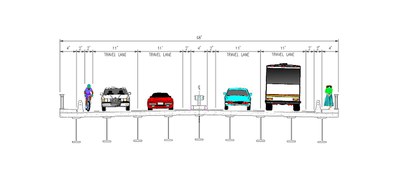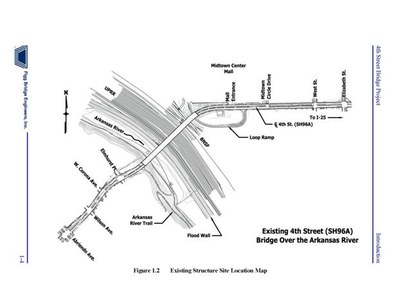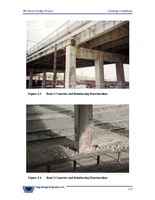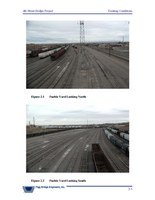Bridge History
Bridge plans and a detailed description of existing conditions with site photographs can be found in the Structure Concept Report (FIGG, December 2001). Below are highlights of the information contained in that report as well as an updated description of conditions based on the latest CDOT inspection report dated March 18, 2002.
Existing Bridge Typical
The existing 4th St. Bridge, structure number K-18-Z, was constructed in 1958 and is approximately 1068 feet long and 68 feet wide. The bridge superstructure is constructed of built-up riveted steel plate girders with a cast-in-place mildly reinforced concrete deck (non-composite). Lead based paint was used for corrosion protection. The substructure bents are multiple column and bent cap construction. There are seven spans ranging in length from 117 feet to 202 feet. The maximum span length over the Arkansas River is 202 feet, over the UPRR, 182 feet and over the BSNF, 117 ft, 5 inches. The existing configuration results in five piers in the Pueblo Yard, and one pier on the western bank of the Arkansas River. The existing bridge has a Sufficiency Rating of 24 out of a possible 100 (SIA, 2002). The sufficiency rating is a function of the structural adequacy, safety, serviceability, functional obsolescence, and public use of the bridge. The overall structural condition was rated as "meets the minimum tolerable limits to be left in place as is," and the bridge has been classified as "Structurally Deficient" (SD). The latest inspection report indicates that there is inadequate load carrying capacity compared to the original and current standards of design. The bridge was originally designed for an HS20 vehicle load (36 tons), which was the standard at the time of construction. The State of Colorado now requires that new bridges be designed for an HS 24 or HL 93 vehicle load (45 tons), to reflect the heavier truck traffic common today. Inventory Operating level load rating, as reported in the latest inspection report, is summarized in Table 2.2 below. The table shows that the bridge deck and the girders in spans 3 through 5 have 65% and 75% of the capacity of the original HS 20 design loading at inventory level. This equates to 52% and 60% of current vehicle design load requirements. Table 2.2 Existing Bridge Load Rating Results Bridge and approach geometry are substandard by today's design requirements. The down grade of the bridge from west to east combined with tight curvature on the east end have been blamed for unsafe driving conditions especially in inclement weather. Similarly, the reverse curveon the west approach has been identified as undesirable and somewhat of a safety concern for motorists. The structure profile provides adequate vertical clearance to the Loop Ramp roadway and top of railroad tracks below. Existing Structure Site Location Map Pueblo Yard Looking North and South
Structural Member
Deck Slab
Unit 1 Girders Spans 1 and 2
Unit 2 Girders Spans 3 - 5
Unit 3 Girders Spans 6 and 7
Inventory (tons)
Operating (tons)




